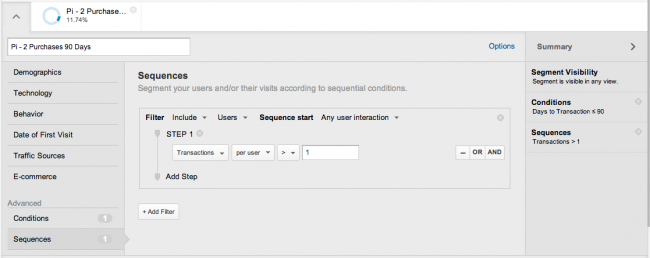
I was the kid who sorted out Skittles by color.
My favorite flavor was lime, which they’ve since changed to green apple — an atrocity if you ask me.
That isn’t my point today, but I think it’s influenced how I work as a marketer.
Google Analytics has done a lot of work around their segmentation tool.
I won’t give you the 101 on it. I’ll leave that to Justin Cutroni. He wrote a fantastic piece on the new parts of the tool in July.
Much like the Skittles rainbow, you can learn a lot about your site’s marketing mix by segmenting the various colorful, tasty pieces out and consuming them individually.
How do I create a segment?
Simple.
In nearly any analytics report, click the down arrow just underneath the ribbon under the report title:

Then, click the lovely “Create new segment” button:

You’ll get a really intimidating screen like this:
But don’t worry, I’ll have a screen cap of the exact settings for each segment later on.
Hit me the with segments!
Here are 5 Google Analytics custom segments I find particularly useful these days.
1. New mobile visitors
Questions answered by this segment:
- What do the most demanding visitors in the mobile segment do on my site?
- How is my new adaptive or responsive mobile experience doing?
How to build this segment:

Ways to use this segment:
Compare it against All Visits to see if you’re over/under average Engagement and Conversion Rate.
Use it to see which devices folks are on when they get a first impression of your site.

2. Two purchases over 90 days
Questions answered by this segment:
- What products are your most loyal customers buying?
- Which products do I remarket to past purchasers?
How to build this segment:

Ways to use this segment:
Go to the Product Performance report and set City as your secondary dimension.
Hone in on products sold to someone in a podunk town. Chances are it was the same person. It’ll show you which products they purchased.
And the timeline will show you how quickly they came back to buy the second item.


Are folks buying a device and coming back later for accessories? Buying a guitar and coming back later for a case? This is all super insightful when you do remarketing to past purchasers.
3. Best 4th level page
Questions answered by this segment:
- What do visitors who deeply research my product or service look like?
- What channels drive these visitors?
- What other pages are they looking at?
How to build this segment:
Making this segment requires some research. Go to the Content Drilldown report and click on the top one in the list until you get down several levels:



Then build your segment around your most popular page down a few levels:

Ways to use this segment:
Go to your All Traffic report and see how people are reaching this popular deeper page on the site and what actions they’re taking.
Use that knowledge to discern whether you should move the page further up in your site hierarchy to help folks reach it easier.
4. Top non-brand paid keyword
Questions answered by this segment:
- With organic keyword data going away – How do subsequent organic visitors, who clicked on a paid ad previously, interact with my site?
How to build this segment:
This one will also require some research. Go the AdWords Keywords report and look for your top non-brand keyword by visits or by revenue, whichever you prefer:
Use that to build your segment:

Ways to use this segment:
Drill down to organic traffic once the segment is applied and set landing page as your secondary dimension.
You’ll get all kinds of great insights into entry points and engagement based on organic search visits that are at least tied to a specific search query somewhere in the click stream:
Then you could rinse and repeat this process for your Top 5-10 Non-Brand paid keywords to get more insights.
5. Returning social visitors
Questions answered by this segment:
- Is the money you’re investing in Facebook curation and Twitter interaction paying off?
- What other marketing channels does social influence?
How to build this segment:
Since there’s no way in the segmentation tool to just check Yes or No for a social visitor, you’ll need to specify social networks by name in a Regular Expression under the Source field:

How to use this segment:
Look at the landing pages that people are returning to after they discover you through a social source. That gives you a fantastic look at which pages are really sticky and reusable resources for people.
For us, our Content Inventory post and Title Maker tool are huge.
Have you made any segments with this tool? What do you think of these ones?
Share your thoughts in the comments!
























Hi Michael,
So agree with you Google Analytics should be taken very seriously these days, its sad lots of SEO’s dont check there organic traffic on Analytics,. only on WBT.
I concur.
Ignoring Google Analytics simply because you can’t get Organic keyword data out of it any more is a pretty blinders-on view of SEO.
SEO is largely content-driven. How are you going to know how people respond to content without your analytics data?
Great stuff Michael!
Very handy and timely as just build a completely responsive eComm site and tying in #1 will definitely give us insights about not just device but who really uses our mobile site.
They’re all great but # 2 & 3 are standouts and very fresh perspective on segmentation. Never thought of those.
Question, will #2 continue tracking purchases or just the next transaction?
Cheers
Great writeup! I appreciate the in depth screen shots and explanations. I see I have some exploring to do in Google Analytics now…
Great tut. I didn’t know about some of these features in Google Analytics. Thx!